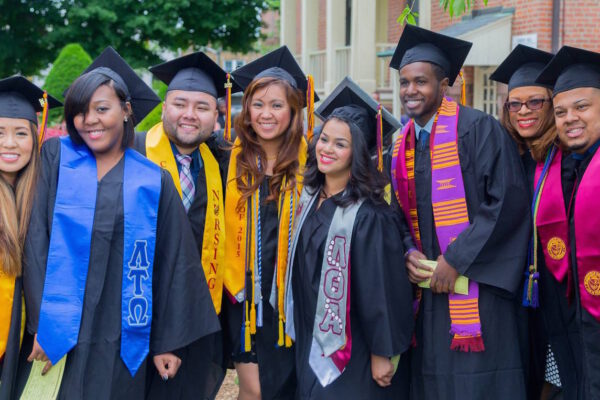By Gina A. Garcia & Morgan Taylor
This blog is part of a series highlighting the findings from Pulling Back the Curtain: Enrollment and Outcomes at Minority Serving Institutions.
Hispanic-Serving Institutions (HSIs) have a rich and storied history. Beginning as a grassroots effort in the 1980s, HSIs were first recognized by educators and policymakers as institutions that enroll a large concentration of Latinx[1] students. Created in 1986, the Hispanic Association of Colleges and Universities (HACU), the membership association for HSIs, served as a leader in the effort to persuade Congress to formally recognize HSIs in 1992 and target federal appropriations to these institutions.
Because an institution’s eligibility to become an HSI is predicated on enrollment, the number of HSIs changes on an annual basis. Currently, over 470 two- and four-year institutions meet the enrollment threshold to apply for eligibility to participate in the U.S. Department of Education’s Developing Hispanic-Serving Institutions Program (found in Title V of the Higher Education Opportunity Act), and more than 300 are inching toward that threshold, a group also known as “Emerging HSIs.” Research shows that as Latinx student enrollment in higher education and the number of institutions eligible to become HSIs grow each year, HSIs’ significance to national college completion and workforce goals also grows.
Despite falling under one umbrella, it is important to recognize that HSIs are not a monolithic group, but are diverse by type, size, Carnegie Classification, regional location, institutional resources and expenditures, and purpose. In 2015–16, HSIs were almost evenly split between two-year (49 percent) and four-year (51 percent) institutions. Two-thirds of HSIs were public institutions, compared to one-third private institutions. Geographically, HSIs were located in 19 states across the U.S.; however, the vast majority of HSIs (81 percent) were heavily concentrated in just five states—California, Florida, New Mexico, New York, and Texas—and Puerto Rico. Emerging HSIs were more spread out across the United States, located in 35 states and DC. In many ways, HSIs are as diverse as the higher education enterprise itself.
Graduation as an Indication of Serving Latinx Students
Graduation rates are one outcome worth considering as an indicator of how effective HSIs are at serving Latinx students. ACE’s Center for Policy Research and Strategy recently released a one-of-its-kind report, Pulling Back the Curtain: Enrollment and Outcomes at Minority Serving Institutions, using data from the National Student Clearinghouse (NSC) to examine enrollment and outcomes of students who start college at HSIs and other minority serving institutions. NSC data were ideal since they provide a more robust picture of student outcomes because they capture students as they move across institutions and states. Findings from the report show that students attending HSIs do not fit the profile of students captured by traditional graduation rates—those who enroll exclusively full time. Instead, the majority of students enrolled at public HSIs move between full-time and part-time status, and nearly half of all students at private four-year HSIs attend through mixed enrollment (45 percent).
Further, the authors found that the completion rate for exclusively full-time students at HSIs, the NSC sub-cohort most comparable to the cohort used to calculate the federal graduation rate, was higher than the federal graduation rate across all sectors. Analyzing NSC data, the authors of the report found:
- Exclusively full-time students at public four-year HSIs complete within six years at a rate of 74.1 percent, compared to 42.7 percent using the federal graduation rate.
- Exclusively full-time students at private four-year HSIs had a six-year completion rate of 77.9 percent, compared to the federal rate of 49.1 percent.
- Exclusively full-time students at two-year public HSIs had a four-year completion rate of 40.3 percent, compared to the federal four-year completion rate of 25.5 percent.
Other Indicators of Serving Latinx Students at HSIs
While HSIs enroll a high concentration of Latinx students, and it appears that they are graduating students in fairly high numbers, many have raised the important distinction between enrollment/graduation and service. Higher education has reached the moment when collectively, HSI leaders, advocates, scholars, and legislators must decide what students can and should garner and experience as a result of attending an HSI. Put more simply: what does it mean to serve Latinx students beyond enrollment and graduation?
As student demographics have changed, so too have students’ needs. As such, the idea of “serving” students has evolved to include providing academic and social support and fostering a positive campus racial climate. As HSIs look to the future, beyond their commitment to enrolling and graduating a diverse student body, they are right to construct organizational identities that exemplify what it means to be Latinx-serving. Given the high concentration of Latinx students at HSIs, and as the Latinx population enrolling in postsecondary education continues to grow, it is critical to understand what HSIs are doing to ensure their success and foster an inclusive environment.
The national nonprofit Excelencia in Education recognizes programs at institutions, including HSIs, which have shown effectiveness in accelerating the success of Latinx students. Excelencia’s Growing What Works database serves as a resource of programs that the organization has recognized as leading examples of institutional policies and practices that promote Latinx student success. A few examples:
- City Colleges of Chicago-Harry S. Truman College’s Transitional Bilingual Learning Community (TBLC) works to increase enrollment of Latinx English language learners in the institution’s credit program. This two-semester, full-time credit initiative was designed to help Latinx English language learners transition into college-level courses taught in English, using learning communities to provide students with academic support, bilingual, and financial services. The program provides a space in which students can learn the culture of higher education while also supporting their identities and experiences. TBLC students earn their associate degree at four times the rate of nonparticipants and also transfer after earning their degree at seven times the rate of nonparticipants.
- California State University, Fullerton’s Enhancing Postbaccalaureate Opportunities at CSUF for Hispanic Students (EPOCHS) program seeks to close the achievement gap between Latinx and non-Latinx graduate students through bilingual workshops for students and families, as well as tutoring and mentoring services. EPOCHS addresses campus climate through cultural competency workshops for faculty and provides outreach activities with local high schools, community colleges, and nonprofit organizations. As a result, the three-year graduation rate for master’s students increased from 51 percent in 2010 to 63 percent in 2015. Of faculty who attended cultural competency workshops, 100 percent stated it helped increase their understanding of challenges faced by Latinx students.
- South Texas College’s Early College High Schools Program aims to close achievement gaps through partnerships with 30 high schools, preparing ninth and 10th graders for college-level courses and offering eligible 11th and 12th graders the opportunity to enroll in and complete dual credit courses in high school. The program focuses on low-income students who are likely to be the first in their families to attend college. It provides them a nurturing environment in which they can receive the additional support needed to succeed. Over the last five years, more than 1,400 students have graduated with an associate degree at no cost to the student or their family.
The institutions highlighted here offer a small taste of what HSIs are doing to help their students succeed. If we are to invest in this growing group of institutions and the students that they serve, however, adequate funding is necessary.
Federal Investment in HSIs
While the practices above work to increase the success of Latinx students, HSIs need the funding and institutional capacity in which to provide these efforts. HSIs serve students who often require embedded support to persist and graduate, necessitating the resources or capacity to provide such support—which is why federal, state, and other funding is so important to the sustainability of HSIs. An examination of 20 years of Title V funding shows that 70 percent of grant recipients invested their funding into three activities: faculty and curriculum development, student support services, and funds and administrative management. Evidence shows that investing in these activities improves students’ academic achievement and institutional capacity to facilitate such achievement.
However, to continue serving Latinx students, HSIs need more adequate funding. According to HACU, HSIs receive just 69 cents per student for every federal dollar going to all other colleges and universities. Furthermore, ACE’s 2015 brief on government investment in public HSIs shows that federal funding has decreased in recent years as the number of institutions competing for these funds has increased. Due to the financial backgrounds of the student population they serve, HSIs have limited ability to raise tuition as a revenue source. This in turn increases their dependence on federal funding and vulnerability to declines in federal appropriations.
It is well documented that greater institutional resources lead to greater outcomes. Providing further support to these institutions, therefore, is critical given the important role they play, and will continue to play, in the education of Latinx students nationally.
HSIs serve as exemplars for actively enrolling, serving, and graduating diverse students. Yet serving Latinx students requires intentionality on behalf of institutions and support from the federal government. With the increase in Latinx students enrolling in postsecondary education and the subsequent increase in the number of HSIs, these institutions should remain at the top of all policy priority agendas.
[1] We use the term, “Latinx” rather than “Latino,” as Latinx is a gender inclusive term for people who self-identify as having roots in Latin America, including Central America, South America, Mexico, and the Caribbean.
If you have any questions or comments about this blog post, please contact us.




